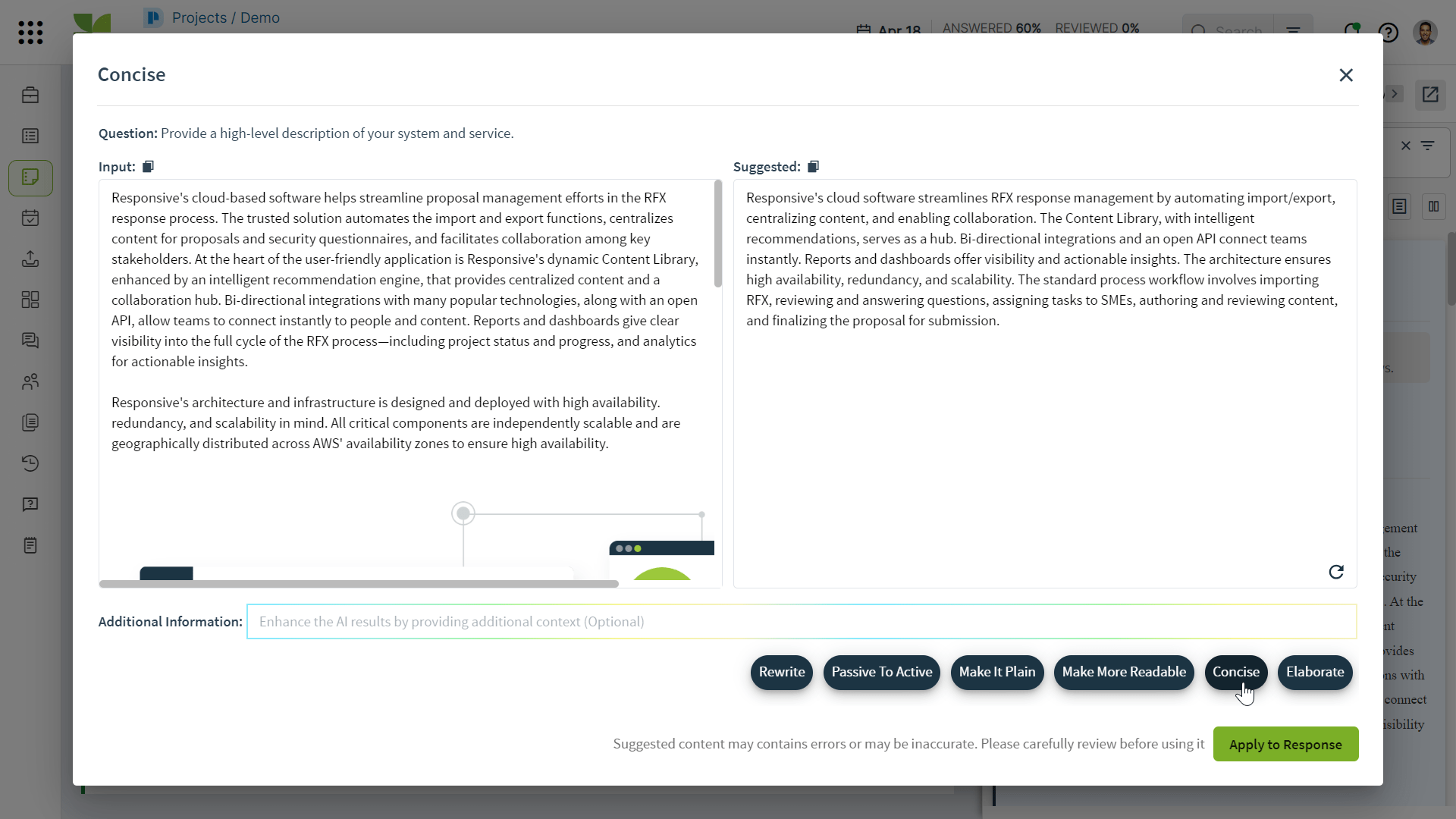This Responsive customer is a U.S.-based investment management firm founded in the 1970s. The firm manages U.S., international and global portfolios for institutional and high-net-worth investors worldwide. When their legacy RFP software provider failed to live up to expectations, the organization implemented Responsive (formerly RFPIO) as part of a long-term response strategy to manage RFPs, RFIs and DDQs.
This customer initially deployed Responsive to manage content they use for responding to RFPs, RFIs and DDQs. To take full advantage of Responsive’s Strategic Response Management Platform — including project management, collaboration and making access to response-ready content even easier to all users — the investment management firm of about 200 employees engaged Responsive premium professional services. While efficiency and productivity benefits are already in effect, expectations are high for an increase in speed, quality and morale, as well as the dismantling of team siloes.
Key Takeaways :
 Content Library provides a single source of content truth for responses to RFPs, RFIs and DDQs.
Content Library provides a single source of content truth for responses to RFPs, RFIs and DDQs. Availability of SME-reviewed assets in the Content Library eliminates repetitive requests.
Availability of SME-reviewed assets in the Content Library eliminates repetitive requests. Premium professional services fine-tunes and optimizes Responsive and increases productivity so the firm doesn’t have to add headcount.
Premium professional services fine-tunes and optimizes Responsive and increases productivity so the firm doesn’t have to add headcount.
The challenge
For 15 years, the RFP/RFI Team Lead has been part of the team that responds to requests for proposals (RFPs), requests for information (RFIs) and due diligence questionnaires (DDQs). All of these external requests are mission-critical to the investment management firm’s sales and client relations processes.
At first, she worked from Word files. That was way too inefficient, and there were no systems tying together the response process. She made due with this manual process for her first 10 years, but she knew there had to be a better way. She had hoped she’d found it when the firm invested in its first RFP software point solution.
“But they had bad customer service. We wanted something new that offered more help with automation and compliance.”
– RFP/RFI Team Lead
While shopping for new solutions, Responsive invited the Team Lead and her team to stop by a regional user conference being held in Chicago. “We demoed a couple of things and then we actually got to speak to your CEO. He asked why we were interested and the whole time we felt like, ‘Wow, we’re talking with the CEO! This is so great!’ It was such a difference from where we’d been and it made us very interested to see what else you could do.”
Engaging Responsive professional services to optimize deployment
The organization upgraded to Responsive toward the end of 2019, and then the pandemic hit. Onboarding did not go as planned, and some of the bad habits that began with their previous vendor carried over to Responsive.
It became evident that the investment management firm was not using Responsive to its full potential. All of their content was in the library, but it was in disarray. “We asked for headcount to help organize the Content Library, but our president asked us to find a way to make the technology work harder,” said the Team Lead.
Enter Responsive premium professional services. The professional services team began providing operational, strategic and visionary support to help the investment management firm take advantage of all the capabilities available on the robust Responsive platform.
The goal of a professional services engagement is to act as the remote Responsive expert for any organization. The team cleans up the Content Library and establishes Projects, in-app collaboration and project management, custom reporting and other functionality for the deployment.
Mitigating risk exposure due to response challenges
The investment firm is working with Responsive premium professional services to mitigate three types of risk resulting from response challenges associated with their content, resource allocation and rapidly changing regulatory environment.
Employee experience risk: Subject matter experts (SMEs) were tired of repetitive requests for the same information. The proposal team and management were spending too much time on manual processes and repetition, resulting in excess stress because they were neglecting other responsibilities. Executives were frustrated that the RFX response process was causing so much strain across the organization.
Revenue risk: Inability to efficiently find the right content forced the RFP/RFI team to search for it elsewhere. If content still could not be located, then requests were escalated to SMEs. This slowed down RFI and RFP response time, the latter of which slowed down the sales process.
Business risk: In the financial services industry, proving compliance is table stakes for winning mandates and maintaining client relationships. Errors or delays in an RFP response can cost investment firms a mandate. Portraying a lack of urgency or providing incorrect or out-of-date information in an RFI or DDQ can break down trust quickly.
Avoiding RFP bottlenecks with better content searchability
The RFP team only completes responses when the investment firm has an established relationship with a prospect or client, which means the sales team has already made the go/no-go decision by the time an RFP lands on the RFP Team Lead’s desk. The sales team relies on the RFP team to develop the response. Sometimes they have time to review the response prior to submission, but ultimately, it’s the RFP Team Lead and her team’s responsibility to build a high-quality proposal.
The average RFP for the organization is about 60 pages, but they range in length from 20 pages to a hundred. The RFP team often has multiple RFPs in flight, and every one of them must be completed before proceeding to the next step, which is usually an in-person portfolio review meeting.
Responsive helped minimize the RFP bottleneck for the Team Lead, even while using only a fraction of its capabilities. They had used their previous RFP software only as a content repository for proposal content, so they initially set up Responsive in the same way. Still, the RFP team has seen a major improvement:
“The search features are a big plus, and we love how easy it is to copy and paste from there.”
– RFP/RFI Team Lead
Streamlining the repetitiveness in RFIs and DDQs
In addition to RFPs in flight, the team also manages responses to quarterly RFIs and annual DDQs. Clients who invest with the firm want to know how their portfolio is performing.
RFIs are high volume and many are being worked on at the same time (by the same team also working on RFPs). There are fewer DDQs, but they are much longer than RFIs and require more detailed answers. Both ask for historical and specific vehicle data and require frequent collaboration with SMEs to complete.
Organizational SMEs involved in response functions include:
- Traders
- President
- Environmental, social and governance (ESG)
- Diversity, equity and inclusion (DEI)
- Sales staff
- Researchers and analysts
- Business continuity and disaster recovery (BC/DR)
The RFP Team Lead needs the SME knowledge to provide answers about philosophy, process, strategy, assets under management (AUM), investment vehicles and much more. Some of the information, such as portfolio details, has to be customized because it’s specific to the client, but much of the information is applicable to many responses.
“[The RFP/RFI team] is a small team that relies on specialized knowledge of SMEs,” she said. “While we try not to bother them with repetitive questions, it does happen sometimes.
“But now, our subject matter experts say, ‘You just asked me this five times. Can we add it to Responsive?’ Done! That’s a huge plus for us.”
– RFP/RFI Team Lead
Accelerating time to value with professional services
The RFP Team Lead has seen her role change dramatically since she first started her career at the investment firm 15 years ago, from manually updating various Word documents to now overseeing the [proper] deployment of a strategic response management platform.
It’s still early days in her engagement with Responsive premium professional services, but she’s already recognized significant progress in how her company benefits from the platform.
| Before Responsive | After Responsive |
|---|---|
| Content was difficult to find and impossible to track, resulting in too much repetition and lack of insight into what was working. | Content Library provides a single source of truth for responses to RFPs, RFIs and DDQs. Custom reporting allows for in-depth tracking and management of all content. |
| Proposal manager and director of marketing operations spent a disproportionate amount of time on the proposal and response process, which led to employee experience risk that escalated to the firm’s president. | All stakeholders in the response process — from the proposal manager to the director of marketing operations — are able to be more productive rather than spin their wheels on content management, access and repetition. |
| As a necessary step in the process to win a mandate, sales teams were frustrated when they had to wait for RFP responses before proceeding to the next step. | Faster turnaround of responses limits the RFP bottleneck, which can hold up a mandate. |
| Subject matter experts (SMEs) voiced frustration at receiving repetitive requests for the same information and were upset about the infringement on their time. | Availability of SME-reviewed assets in the Content Library eliminates repetitive requests. |
| Initial onboarding of Responsive defaulted to the workflow of the previous RFP software provider, so many built-in features and capabilities were not in use. | Premium professional services fine-tunes and optimizes Responsive and increases productivity so the firm doesn’t have to add headcount. |
Responding faster, improving quality and scaling quickly
As their Content Library grows more functional, the RFP Team Lead is working with professional services on several projects to increase efficiency and productivity even more than what they’ve accomplished so far. Some of the most impactful include:
- Deploying Responsive Projects to manage the full response lifecycle — from intake to building templates, project management to content management, and collaboration to export — through Responsive.
- Utilizing custom reports to gain insight into what’s been successful with past RFPs and RFIs and to ensure compliance.
- Integrating with Salesforce to streamline the workflow for her manager and the sales team.
- Activating Responsive LookUp to enable traders, the sales team and rest of the firm’s teams — which tend to be siloed — to search content for presentations and their own knowledge from everywhere they already work. This also will help with reporting through online portals.





